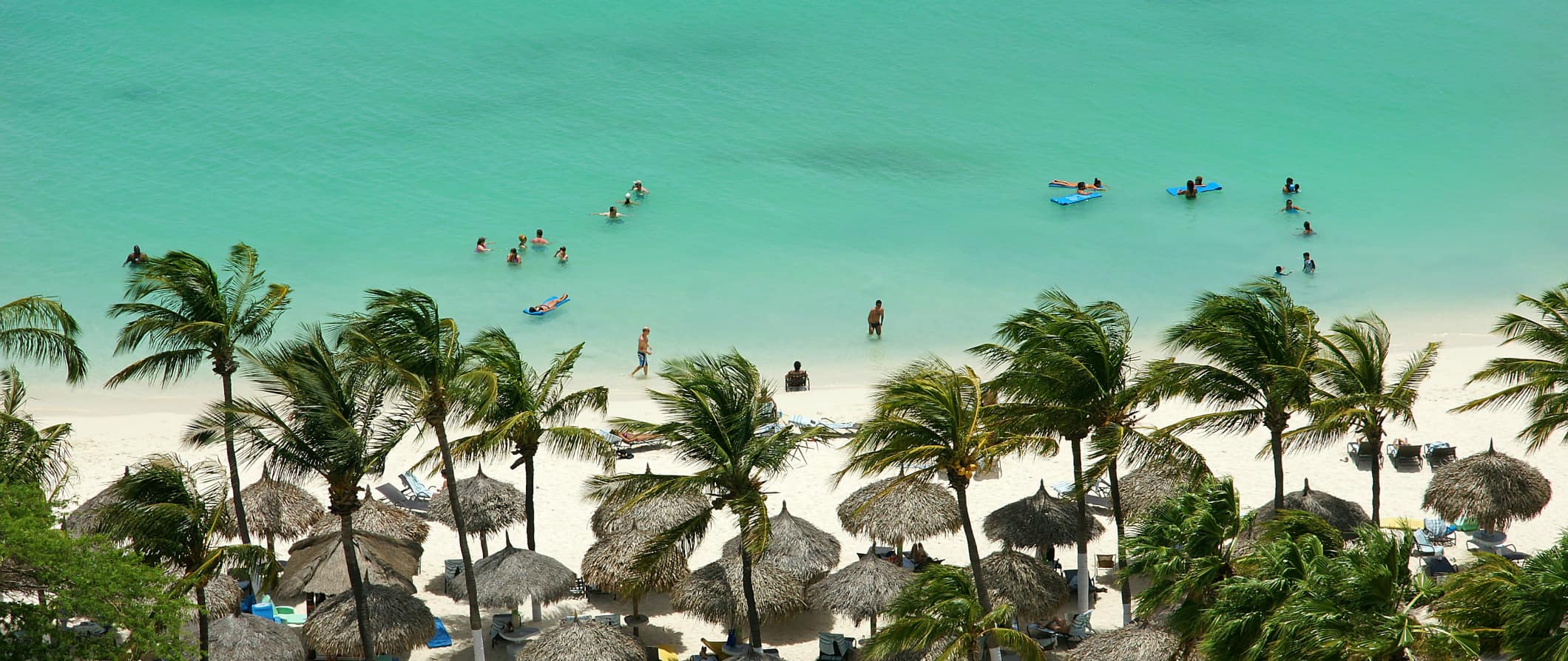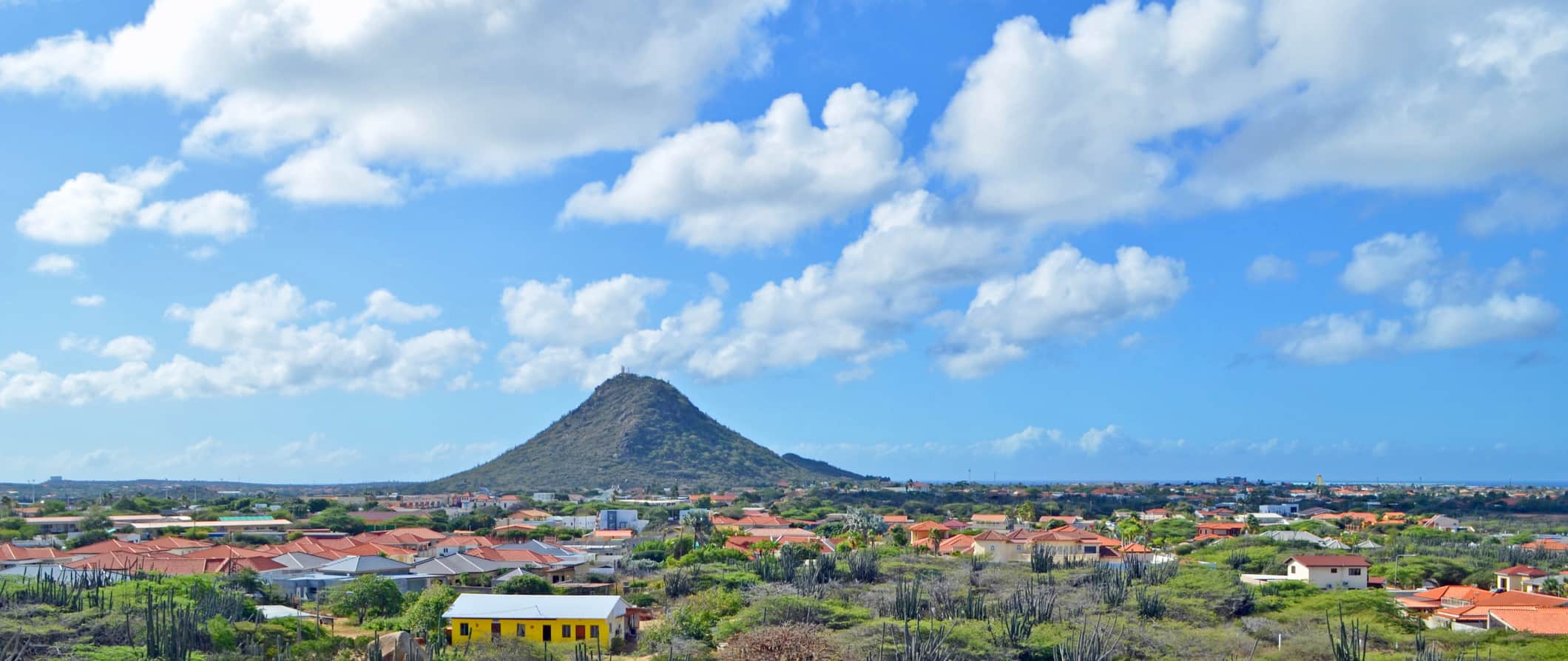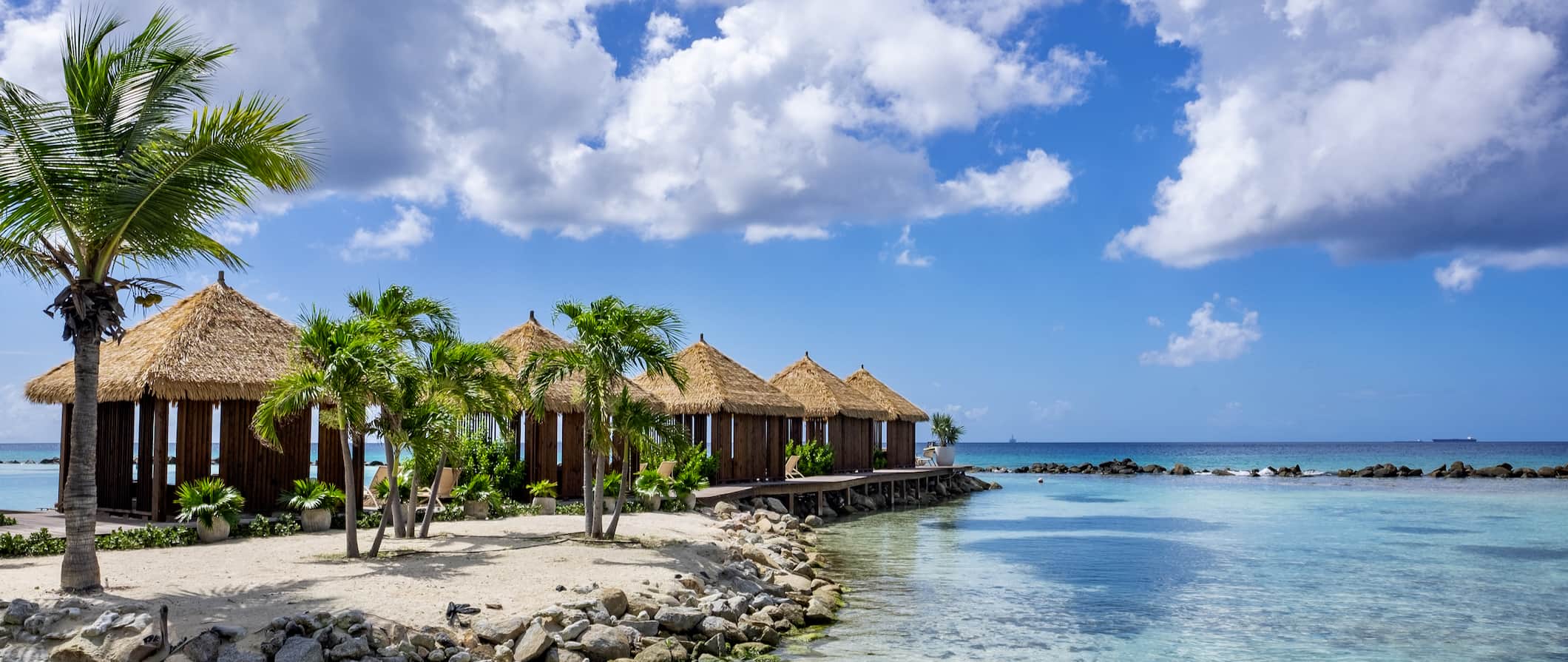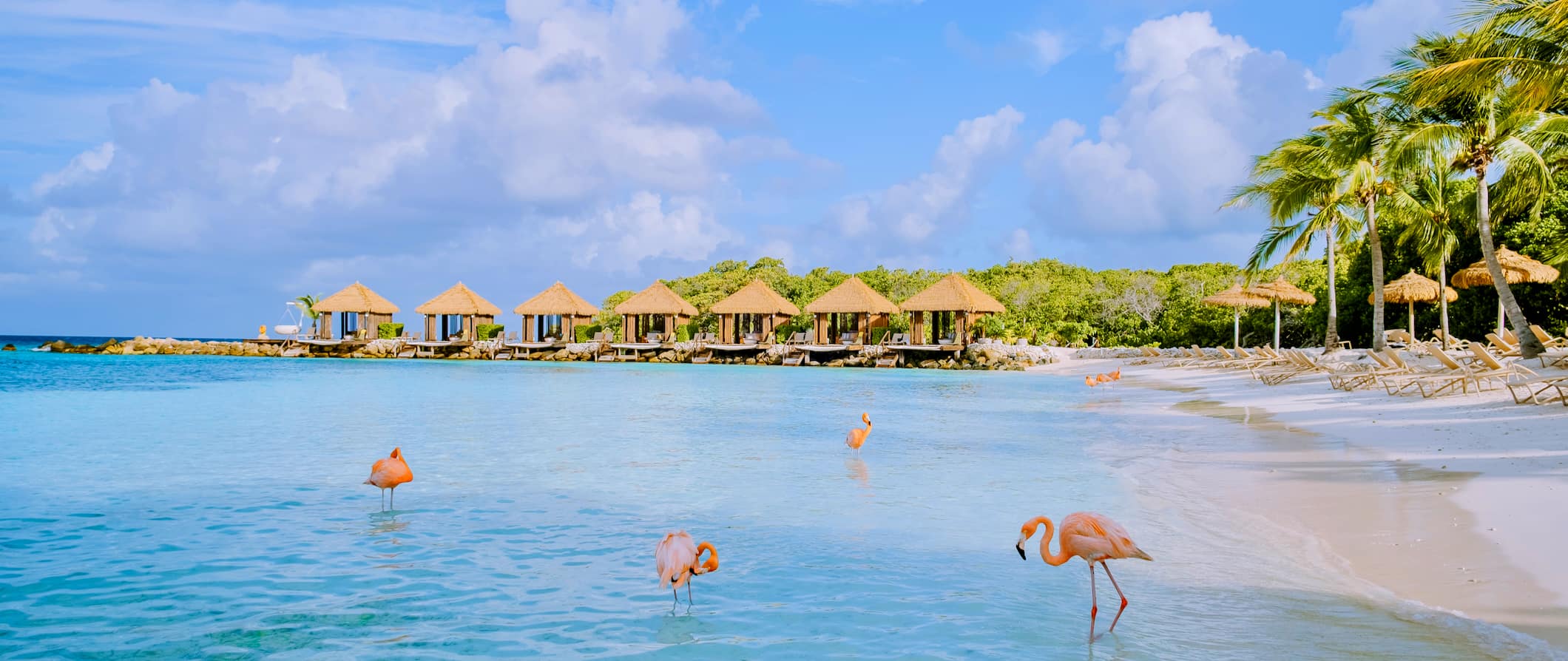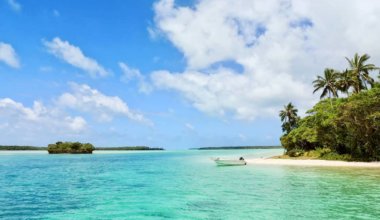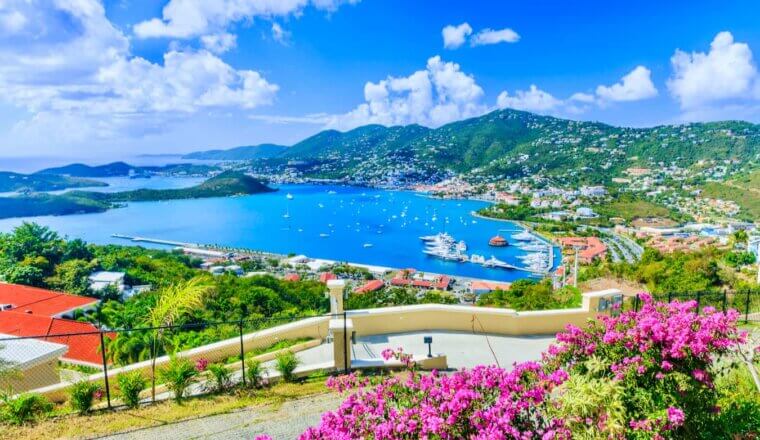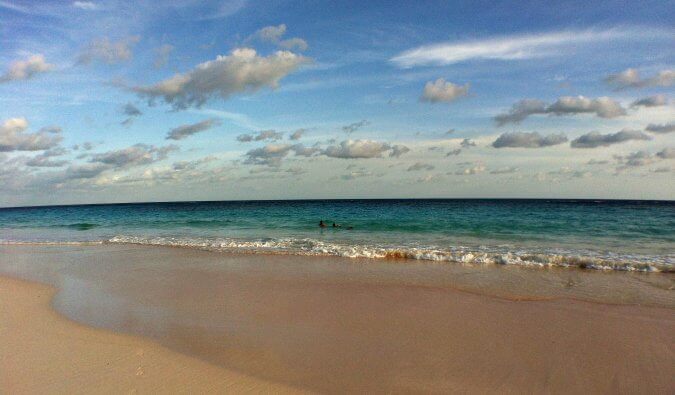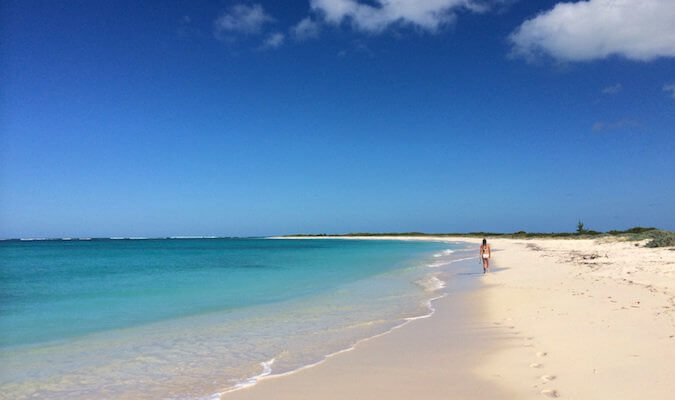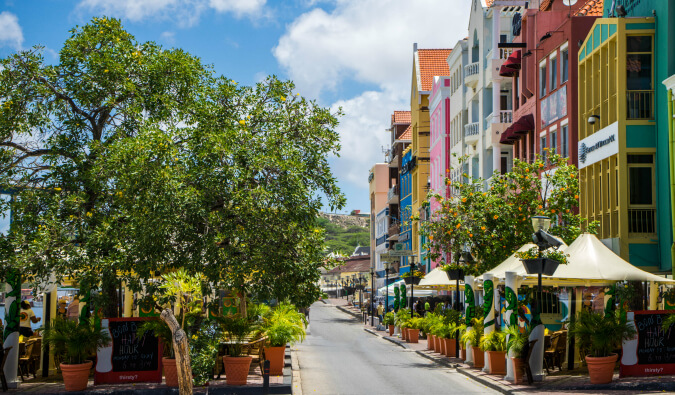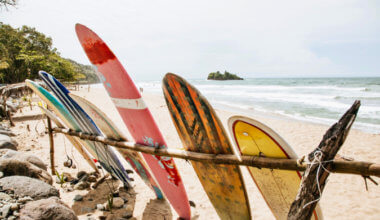Located in the Netherlands Antilles, Aruba is home to white sandy beaches, crystalline waters, colorful fish, and picturesque ocean views. It’s one of the most popular tropical getaways in the world and a favorite of travelers who visit the Caribbean.
Here you’ll find pastel-colored Dutch houses juxtaposed against the natural island backdrop, transporting you to a tropical version of Amsterdam. Aruba’s not limited to the beaches and towns, though. Since it doesn’t get a ton of rain, the arid landscape has huge boulders and cactus forests scattered across it.
Like most other Caribbean islands, Aruba is expensive. This is a destination where honeymooners and luxury travelers go to relax so you’ll pay a premium for hotels, food, and activities in Aruba.
That doesn’t mean it’s impossible to visit Aruba on a budget though — it just takes some planning.
But, no matter your budget, this Aruba travel guide has all the practical information you need to help you plan your visit so you can make the most of your time in this island paradise!
Table of Contents
Top 5 Things to See and Do in Aruba
1. Go Snorkeling
Snorkeling is the number one thing to do on the island. The shores are filled with brightly colored coral, angelfish, clownfish, and even the occasional octopus. Many hotels offer their guests free use of snorkeling equipment (feel free to pack your own though). Arashi Beach is best for beginner swimmers because of its shallow waters and sandy bottom, but a popular stop for snorkeling tours is Boca Catalina and its neighbor to the north, Catalina Cove, for the plentiful fish and wide variety of sea life. Expect to pay at least 100 AWG per person for a two-hour guided snorkeling trip.
2. Explore Oranjestad
Aruba’s capital city is styled in Dutch architecture, with homes featuring curved roofs and plenty of pastel colors. Named after the Prince of Orange, here you can hop on and off the free streetcar which runs through the downtown area, home to the shopping district, as well as the National Archaeological Museum (free entry) and the Historical Museum of Aruba (9 AWG). Don’t miss Fort Zoutman, built by African slaves in the 18th century.
3. Sail around
Sailing is very popular and you can find snorkeling, sunset, dinner, and party cruises here on anything from small catamarans to big pirate ships. Depending on your budget, you can opt for a more inclusive cruise like The Tranquilo, which comes with refreshments and lunch for 180 AWG. Pelican Adventures offers a more basic 2.5-hour snorkeling cruise for 105 AWG.
4. Go diving
Aruba has lots of dive sites, including the Antilla wreck, a German ship that was scuttled at the outbreak of World War II, as well as sunken airplanes just off Renaissance Island. There are all kinds of wildlife to be seen, including stingrays, moray eels, yellowtail snappers, and more. Not a certified diver? There are plenty of options for introductory diving courses as well if you want to test the waters. Single-tank dives start from 155 AWG.
5. Hike Hooiberg
Also known as Haystack Mountain, Hooiberg stands over 500 feet tall in the center of Aruba and is the perfect lookout for panoramic views over the island. On a clear day, you can see the coast of Venezuela! Bring lots of water and a hat as it’s a steep climb to the top (587 steps to be exact!), and don’t be surprised if you run into a few goats on your way up. It is recommended to do this hike early in the day or late in the afternoon to avoid the heat.
Other Things to See and Do in Aruba
1. Relax on a beach
Aruba’s powdery soft beaches and clear waters make for excellent days full of sunbathing, snorkeling, and swimming. Eagle Beach is the most popular, and its wide stretches of sand mean it’s never too crowded. Then there’s Flamingo Beach on Renaissance Island, where you can hang out with actual flamingos; or Drulf Beach, which is easily accessible from Oranjestad. If you want more solitude and quiet, head to Andicuri Beach, where rocky cliffs frame a wide swath of beachfront extending into the turquoise sea. There’s also Boca Prins Beach, which can be found in Arikok National Park (it has incredible views but watch out for the strong waves).
2. Go kayaking
For a relaxing way to explore Aruba’s coast, hop in a kayak. Most hotels offer their guests free use of kayaks. Otherwise, expect to pay around 45 AWG per hour for a rental. The coastline has a lot of little coves to explore, so take your time. Conversely, you can take a tour with Clear Kayak Aruba. Their clear-bottomed kayaks let you see the reefs and coral beneath you. A two-hour guided paddle costs 120 AWG for the daytime tour and 270 AWG for the night tour.
3. Rent a quad
A quad (ATV) lets you get off the beaten track and explore some of the smaller beaches and jungles on the island. While getting a guide is the best option, you can also explore the island on your own. A half-day quad rental is 199 AWG, while it’s 229 AWG for the full day. Tours start from 215 AWG per person.
4. Go golfing
Expensive holiday resorts and golf go hand in hand. Unfortunately, golf here isn’t a budget-friendly activity. If you want to hit the links, expect to pay 160-300 AWG per round at the island’s championship course, Tierra Del Sol. Its gorgeous 18-hole course is right on the ocean. Another option is The Links at Divi Aruba, where you can get in a quick 9 holes for 162 AWG (club rentals are available for an additional fee).
5. Visit the Archaeological Museum
Aruba has a complex history as it has been invaded by several colonial powers throughout the centuries. This former family home has been transformed into a museum displaying a variety of stone, shell, and ceramic artifacts from Aruba’s distant past, dating all the way back to 2,500 BCE. If you want a better understanding of the island’s long history, stay and watch the documentary film on ancient indigenous life. Admission is free.
6. Find tranquility at the Peace Labyrinth
The Peace Labyrinth sits atop a bluff overlooking the Caribbean. Next to a small chapel, here you can walk mindfully through the intricate outdoor labyrinth of stone, which is meant to serve as a sort of meditation. The entire Labyrinth fell into disrepair in recent years, but in 2019 volunteers gave it an overhaul so it looks great again. The grounds are free to wander.
7. Visit the Donkey Sanctuary
Once a major mode of transportation, donkeys have lived on the island of Aruba for over 500 years. After cars arrived, donkeys became less needed and their population hit record lows. Now, donkeys live primarily in this non-profit sanctuary. It’s a fun place to spend the afternoon, especially if you have kids, as you’re invited to feed and care for the donkeys (no riding is allowed). Admission is free, but donations are welcome.
8. Visit the Collapsed Natural Bridge
Once extending over 100 feet across and 25 feet high, this “bridge” was naturally carved into the coral limestone by the sea until it collapsed in 2005. It’s still a top-rated tourist attraction, serving as a scenic viewpoint and lookout, and can be accessed by car via a dirt road. Nearby is the “Baby Bridge” that still stands, which is also recommended to check out while you’re in the area.
9. Take a jeep tour
One of the best ways to view the island is by taking a 4×4 tour that allows you to see parts of Aruba that lie off the beaten track, including the rugged north coast. There are several different tour options that offer an adrenaline rush as you tear up the backcountry, pause to visit caves and go for a swim and explore hidden beaches. Jeep tours start from 150 AWG.
10. Explore Arikok National Park
Located in the northeastern part of the island, you can find most of Aruba’s flora and fauna in Arikok National Park. At 34 square kilometers (13 sq mi), it makes up around one-fifth of Aruba and has lots of different geological features, including volcanic hills and limestone rocks formed from fossilized coral. The park has a couple of stunning beaches, as well as Conchi, a natural pool that’s only accessible on foot, on horseback, or in a 4×4. Arikok is also home to Cunucu Arikok and Fontein Cave, where you can see rock paintings left behind by the indigenous Caquetío. A day pass costs around 20 AWG.
11. Climb California Lighthouse
You can get amazing views of the west coast beaches and the coral shorelines from the top of this lighthouse. It was named after the S.S. California, which sunk before the lighthouse was built in 1910. It’s located in the northwest of Aruba in the area known as “Hudishibana.” Go at dusk for one of the best sunsets on the island. Admission is 9 AWG.
For information about other Caribbean destinations, check out these guides:
Aruba Travel Costs
Hostel prices – Aruba has virtually no real hostels and very limited budget accommodation options. Budget private rooms cost around 100 AWG per night. Free Wi-Fi is standard and some budget accommodations have pools.
Camping is not available in Aruba.
Budget hotel prices – Budget two- and three-star hotels start at 170 AWG in Oranjestad but are closer to 225 AWG near beach resort areas. Free Wi-Fi is standard and many budget hotels also have pools. Some even include free breakfast.
On Airbnb, private rooms start at 80 AWG per night while entire homes/apartments average closer to 400 AWG per night. Be sure to book early to find the best deals as prices can double when not booked in advance.
Food – The cuisine in Aruba is a mix of Dutch, Caribbean, and South American flavors. Seafood, of course, is king, with mahi-mahi, red snapper, and grouper all being commonly caught around the island. Fresh fruit is also super popular. Be sure to try cool soup (a cold soup made from fruits), sopi mondongo (a stew made with tripe or bone marrow), cala (a spicy fried snack), and fried plantains.
For a casual seafood meal at a restaurant, expect to pay around 30 AWG. For fast food (think McDonald’s), a combo meal costs around 17 AWG. Chinese food on the island averages around 25 AWG per person for a plate and drink, compared to a pizza which costs around 45 AWG for a large.
If you want to splash out, a mid-range three-course meal with a drink costs around 90 AWG (upscale places cost upwards of 100 AWG).
Beer is 8-9 AWG while a latte or cappuccino is 6 AWG. Bottled water costs around 2-3 AWG.
If you plan on cooking your own food, a week’s worth of groceries costs around 130 AWG. This gets you basic staples like rice, pasta, seasonal produce, and some meat or seafood. Be sure to do your shopping at large supermarkets as opposed to mini-marts, as they tend to overcharge for convenience.
If you get a chance, order seafood at Zeerovers. It’s delicious!
Backpacking Aruba Suggested Budgets
If you’re backpacking Aruba, my suggested budget is 145 AWG per day. This assumes you’re staying in a hostel or cheap Airbnb, cooking all of your meals, limiting your drinking, taking the bus to get around, and doing mostly free activities like swimming and relaxing on the beach. If you plan on drinking, add another 10-20 AWG to your daily budget.
On a mid-range budget of 300 AWG per day, you can stay in a private Airbnb or budget hotel, eat out for a couple of meals, enjoy some drinks, take the occasional taxi to get aroundm and do some paid activities like diving or a snorkeling tour.
On a “luxury” budget of 560 AWG or more per day, you can stay in a hotel, eat out for all your meals, drink as much as you want, rent a car or quad to get around and do whatever tours and activities you want. This is just the ground floor for luxury though. The sky is the limit!
Aruba Travel Guide: Money-Saving Tips
Aruba caters to vacationers and luxury travelers, so there are not a ton of options here for cutting your budget. Here are the few ways you can save money in Aruba:
- Eat local fish – You’re on an island, so local specialties such as grouper, mahi-mahi, and snapper are less expensive than other seafood options (plus, they’re fresh)! Avoid anything that is imported.
- Enjoy nature – Relax on the beach, go for a hike, or take in a sunset. Aruba’s natural beauty is breathtaking — and free!
- Book online – If you’re planning on going diving, or doing any other expensive activities, be sure to check online for discounts before. Some companies offer discounts for direct bookings.
- Stay with a local – There isn’t a huge Couchsurfing scene here but if you can find a host that can let you stay for free you’ll be able to cut your costs drastically. It’s a great way to meet locals too!
- Bring a water bottle – The tap water here is safe so bring a reusable water bottle to save money and reduce your plastic use. LifeStraw is my go-to brand as their bottles have built-in filters to ensure your water is always clean and safe.
- Cook your own food – Eating out adds up, so book accommodation with a kitchen so you can buy groceries and cook your own meals. It won’t be luxurious but it will be cheaper!
Where to Stay in Aruba
Budget accommodation is limited here so be sure to book early. Here are my suggested places to stay in Aruba (all located in Oranjestad) are:
How to Get Around Aruba
Public transportation – Arubus is the public bus in Aruba, and it gets you everywhere you need to go. Their website, Arubus.com, has a full list of schedules and routes. You can purchase a return ticket for 8.75 AWG, or an unlimited day pass for 17.50 AWG. You pay the driver when you board.
Oranjestad has a free open-air trolley that runs the length of downtown’s main street. It runs every 25 minutes between 10am-5pm. Expect the trolley to be busy on days that cruises come to port.
Taxis – Taxis in Aruba are safe and reliable, but they do not have meters as rates are set by the government. Because of this, there is no ride-shares (like Uber) available on the island. The minimum fare is 12.60 AWG, but you should ask your driver beforehand what the total amount will be.
Car rental – Cars can be rented here for around 75 AWG per day for a multi-day rental. You don’t need an International Driving Permit (IDP) to rent a car here but drivers must be at least 21 and have had their license for two years. For the best prices, use Discover Cars.
Hitchhiking – Hitchhiking is safe here but it’s not very common. You’ll want to be flexible with your schedule as waits will likely be long. Check Hitchwiki for more tips and advice.
When to Go to Aruba
Peak season is January to March when temperatures average in the high 20s°C (mid-80s °F). Expect room prices to soar and for the island to be full and lively.
Personally, I think April to August is the best time to visit Aruba, as this is considered the off-season and prices decrease during this time (there are fewer tourist crowds also). Aruba isn’t part of the Caribbean’s hurricane belt, so there’s not much risk of tropical storms either. Temperatures average around 32°C (90°F).
Fortunately, Aruba is usually pretty breezy, so there’s some relief from the humidity.
How to Stay Safe in Aruba
Aruba is considered one of the safest places to visit in the Caribbean as it’s a small island with a low crime rate. However, it’s still best to not leave your valuables out and unattended at the beach (or anywhere) to avoid petty theft as you would anywhere really!
The San Nicolas area is best avoided at night if you’re alone.
Solo female travelers should feel safe here for all those reasons. However, the standard precautions you take anywhere apply here too (never leave your drink unattended at the bar, never walk home alone intoxicated, etc.). There are numerous solo female travel blogs that can provide more specific tips.
When in the water, be mindful of strong currents. Avoid swimming and other water activities on the northern end of the island for this reason.
Scams here are rare, but if you’re worried about getting ripped off, you can read about common travel scams to avoid right here.
If you experience an emergency, dial 911 for assistance.
Remember to always trust your gut instinct. Avoid isolated areas at night, and be aware of your surroundings at all times. Make copies of your personal documents, including your passport and ID.
The most important piece of advice I can offer is to purchase good travel insurance. Travel insurance protects you against illness, injury, theft, and cancellations. It’s comprehensive protection in case anything goes wrong. I never go on a trip without it as I’ve had to use it many times in the past.
Aruba Travel Guide: The Best Booking Resources
These are my favorite companies to use when I travel. They consistently have the best deals, offer world-class customer service and great value, and overall, are better than their competitors. They are the companies I use the most and are always the starting point in my search for travel deals.
- Skyscanner – Skyscanner is my favorite flight search engine. They search small websites and budget airlines that larger search sites tend to miss. They are hands down the number one place to start.
- Hostelworld – This is the best hostel accommodation site out there with the largest inventory, best search interface, and widest availability.
- Booking.com – The best all around booking site that constantly provides the cheapest and lowest rates. They have the widest selection of budget accommodation. In all my tests, they’ve always had the cheapest rates out of all the booking websites.
- Get Your Guide – Get Your Guide is a huge online marketplace for tours and excursions. They have tons of tour options available in cities all around the world, including everything from cooking classes, walking tours, street art lessons, and more!
- SafetyWing – Safety Wing offers convenient and affordable plans tailored to digital nomads and long-term travelers. They have cheap monthly plans, great customer service, and an easy-to-use claims process that makes it perfect for those on the road.
- LifeStraw – My go-to company for reusable water bottles with built-in filters so you can ensure your drinking water is always clean and safe.
- Unbound Merino – They make lightweight, durable, easy-to-clean travel clothing.
- Top Travel Credit Cards – Points are the best way to cut down travel expenses. Here’s my favorite point earning credit cards so you can get free travel!
Aruba Travel Guide: Related Articles
Want more info? Check out all the articles I’ve written on backpacking/traveling the Caribbean and continue planning your trip:
9 Ways to Explore the Caribbean Sustainably
My 16 Favorite Things to Do in the Virgin Islands
Bermuda: The Impossible Budget Destination? Maybe Not!
How to Save (and Not Save) Money in the Virgin Islands
I Didn’t Like Curaçao (But I Didn’t Hate it Either)
The Best Places on Costa Rica’s Caribbean Coast
